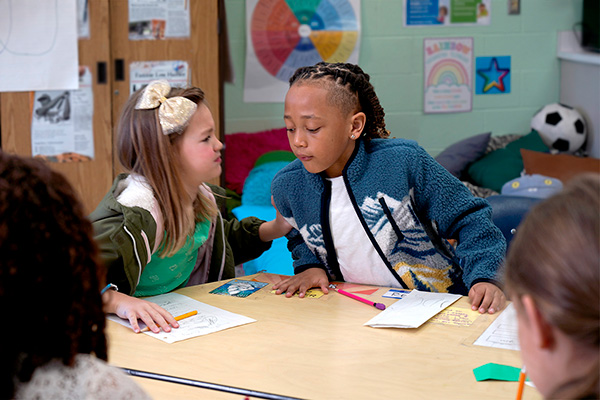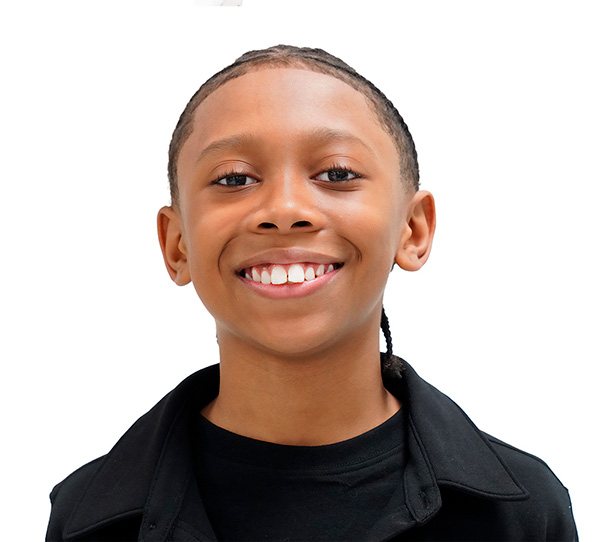How can educators determine why students are engaging in these behaviors?
Page 4: Defining the Behavior
 To assess the function of an interfering behavior, the FBA team must first establish a clear and objective understanding of the behavior itself. The team does this by defining the specific interfering behavior in need of change, often referred to as the target behavior. When first identifying a target behavior, educators tend to describe its form in everyday terms, like “Rayne is rude,” “Deshawn won’t listen,” or “Erick is a bully.” While these informal descriptions might be commonly heard in conversations among teachers, they are not precise enough for an FBA. Instead, the team must develop an operational definition—a clear and specific description of the behavior to be measured.
To assess the function of an interfering behavior, the FBA team must first establish a clear and objective understanding of the behavior itself. The team does this by defining the specific interfering behavior in need of change, often referred to as the target behavior. When first identifying a target behavior, educators tend to describe its form in everyday terms, like “Rayne is rude,” “Deshawn won’t listen,” or “Erick is a bully.” While these informal descriptions might be commonly heard in conversations among teachers, they are not precise enough for an FBA. Instead, the team must develop an operational definition—a clear and specific description of the behavior to be measured.
Because interpretations of behavior are subjective, operational definitions are essential to determining if an observed action qualifies as an instance of the target behavior. When teams have a well-written and mutually understood operational definition of the target behavior, they are more likely to collect accurate and consistent data over time and across team members. A general guideline is that the target behavior should be defined so clearly that anyone could walk into the classroom without knowledge of the student and identify whether the behavior occurs. An operational definition should begin with a broad statement describing the target behavior in terms that are:
- Observable: Details what the target behavior looks and sounds like, not what the student might be thinking or feeling
- Measurable: Describes the target behavior in such a way that it can be counted or timed
- Actively stated: Specifies what the student does, rather than what they fail to do
Though the examples below are not complete operational definitions and are included for illustrative purposes only, they highlight descriptive statements that do and don’t meet these three criteria. Take a moment to consider the differences between the statements in each pair.
| Original Description | Criteria | Improved Description |
| Angela doesn’t follow the teacher’s directions. | ✓ Observable X Measurable X Actively stated |
After being given a verbal instruction, Angela remains engaged in another activity, or engages in a behavior incompatible with following the instruction, for at least 20 seconds. |
| James tries to annoy the teacher by making silly comments in class. | X Observable ✓ Measurable ✓ Actively stated |
Any statement James makes during instruction that is (a) audible to most individuals and (b) either unsolicited (i.e., calling out) or unrelated to class content. |
| Kofi is disrespectful. | X Observable X Measurable ✓ Actively stated |
Any instance in which Kofi rolls his eyes, crosses his arms, or turns away from the speaker. |
Now that you’ve had a chance to compare the original and improved descriptions, consider Johanna Staubitz’s analysis of these students’ descriptions (time: 1:09).

Johanna Staubitz, PhD, BCBA-D
Associate Professor
Department of Special Education
Vanderbilt University
Transcript: Johanna Staubitz, PhD, BCBA-D
For Angela, the original description is not actively stated. It is framed in terms of what Angela is not doing—not following the teacher’s directions—rather than what she is doing. The improved description specifies that when given an instruction, Angela remains engaged in some incompatible behavior. For example, another activity. The original description is also not measurable. The addition of that time criterion of 20 seconds will help an observer decide whether an instance of this behavior qualifies.
For James, the original description is not observable. It names James’s intention, which is more like a “thinking” or “feeling” thing rather than an overt behavior that an observer would be able to see. “Silly” is also subjective. The improved description specifies that audible, unsolicited, and irrelevant comments are the behavior of interest.
For Kofi, the original description is not observable or measurable. The boundaries of what qualifies as disrespectful are unclear. The improved description specifies that the observer should be looking for discrete responses, including rolling eyes, crossing arms, and turning away.
A student’s target behavior will not look the same every time it happens. Therefore, it is helpful to include specific examples and non-examples of the target behavior as part of the operational definition. These additional details help clarify the definition by illustrating what counts when collecting data. FBA teams should identify:
- Examples of what the student’s target behavior might look or sound like. These examples should not be limited to the most common or obvious forms of the behavior; rather, they should also include more unusual cases. To illustrate, let’s revisit the improved definition of Angela’s behavior: After being given a verbal instruction, Angela remains engaged in another activity, or engages in a behavior incompatible with following the instruction, for at least 20 seconds. Examples of this interfereing behavior might include both putting her head down on her desk (more obvious) and continuing to work on another assignment (less obvious). To qualify, either would have to occur for 20 seconds or longer.
- Non-examples of similar actions that could be mistaken for the target behavior but do not qualify based on some aspect of the context. To explore this, let’s revisit the improved definition of James’s target behavior: Any statement made during instruction that is (a) audible to most individuals and (b) either unsolicited (i.e., calling out) or unrelated to class content. In James’s case, it would be useful to include a non-example such as “calls out the answer to a trivia question during a review game” if shouting out is encouraged during such activities.
In this interview, Mary-Austin Modic shares considerations for the FBA team in developing an operational definition of the target behavior. Then, Bettie Ray Butler discusses ways to clearly and objectively develop behavioral definitions.

Bettie Ray Butler, PhD
Professor of Urban Education
University of North Carolina at Charlotte
(time: 1:42)
Transcript: Mary-Austin Modic, BCBA, LBA
We’ll come together as a team, and we will define the behavior that we are looking at, and the behavior will be objective and measurable so we can walk into the classroom and know exactly what we’re going to observe. For instance, if the behavior is tantrum, tantrum to me might be different than a tantrum to the teacher in the classroom next door, so we’re going to define tantrum for the specific student. Tantrum is engaging and screaming for longer than 30 seconds at a volume of more than a classroom setting, could include pushing materials off of desk or stomping feet. We’re going to paint a picture of it—provide examples of what that behavior looks like and provide non-examples so that it’s super clear to whoever might come across that FBA next. I know exactly what the behavior is, and I even have examples to clarify what it might look like across different settings.
One of the first things I always tell people is to be as objective as possible. I always say paint me a picture with your words. What did it look like? And to try to take out any words like frustrated or angry unless the student said, “I am angry.” Just tell me what it looks like. What does frustrated look like? Does it look like the student is clenching his fists and growling under his breath?
It’s important to be that objective because we might let our own opinions and senses interrupt our ABC data. And if I think the student is frustrated and I put that, they might not actually be frustrated, which will then skew our data and not give us a true picture of what’s going on with that student.
It’s important to be objective, too, across the board so we know we’ve written exactly the definition of the behavior, exactly what we’re looking for. So if I come in and I take data, I know that Ms. Smith down the hall is going to come in and take the same data that I’m taking. We’re both looking for the exact same thing because it’s clear. We’ve written it out. It’s objective. Me, Ms. Smith, Mr. Jones down the hall, we’re all measuring the exact same thing.
Transcript: Bettie Ray Butler, PhD
So FBA teams can work to reduce the impact on bias on behavioral definitions. And first, most importantly, is to avoid deficit language. There are certain words that are used to describe behaviors that do not necessarily convey what is happening. Things like disrespectful or aggressive. “I asked a student to place something into my hand, and they shoved it aggressively.” We have to be careful with the verbiage that we use because aggressiveness is oftentimes associated with physical violence, and disrespect is one of those words that is just subjectively situated and cultural based. And cultural based meaning, oftentimes, we hear the term disrespect used with one group more often than we do another group. And so deficit language can create a division between the educators and the youth and their parents or families.
We want to define the behavior—what is or is not happening or taking place—and we want to be very clear about the behavior. We don’t want to typologize the behavior. We don’t want to try to give the behavior a name. We just simply want to define the behavior, and then we want to discuss the behavior with the team. And the team includes school officials, nonschool officials, the student, and their parents and or families.
Returning to the Challenge
As they begin the FBA process, DJ’s and Presley’s teams begin by developing an operational definition of their interfering behaviors.

Recall that DJ’s teacher referred to his target behavior as off task. While this may offer a shorthand for describing the behavior, it is not specific enough to facilitate accurate and consistent data collection. Therefore, the team writes an operational definition that includes common examples and non-examples to support a coherent understanding of DJ’s interfering behavior.
Definition: DJ engages in verbal or non-verbal activities that deviate from established classroom expectations for a given activity.
Examples
- Initiating conversations with peers on topics unrelated to the lesson
- Making jokes
- Leaving his seat and touching other students’ materials
Non-Examples
- Talking with peers about the activity during group work
- Taking a short stretch break with teacher permission
- Leaving his seat with teacher permission or according to classroom expectations
Notice how this definition describes verbal or non-verbal activities, which can be seen or heard (i.e., observable), can be counted or timed (i.e., measurable), and reflect what DJ is doing (i.e., actively stated). The examples and non-examples, while not an exhaustive list, help provide further information about when DJ’s actions are considered an instance of the target behavior.
Activity
 Now it’s your turn. Presley’s target behavior is described as physically aggressive by her teacher. Which description matches the criteria for being observable, measurable, and actively stated and would therefore be the best choice for her team to adopt?
Now it’s your turn. Presley’s target behavior is described as physically aggressive by her teacher. Which description matches the criteria for being observable, measurable, and actively stated and would therefore be the best choice for her team to adopt?

Presley can’t keep her hands to herself.
fb
|

Presley gets angry and violent.
fb
|

Presley initiates forceful physical contact with another person’s body.
fb
|

Presley intentionally hurts people.
fb
|
Given this description, sort the statements below into the appropriate columns for examples and non-examples of Presley’s behavior.
| Examples | Non-Examples |
|
Presley pushes a peer out of her way.
|
Presley clenches her fists.
|
|
Presley hits a teacher on the back.
|
Presley kicks at a backpack on the floor.
|
|
Presley kicks a peer’s shin.
|
Presley bumps into a peer in a crowded hallway.
|
